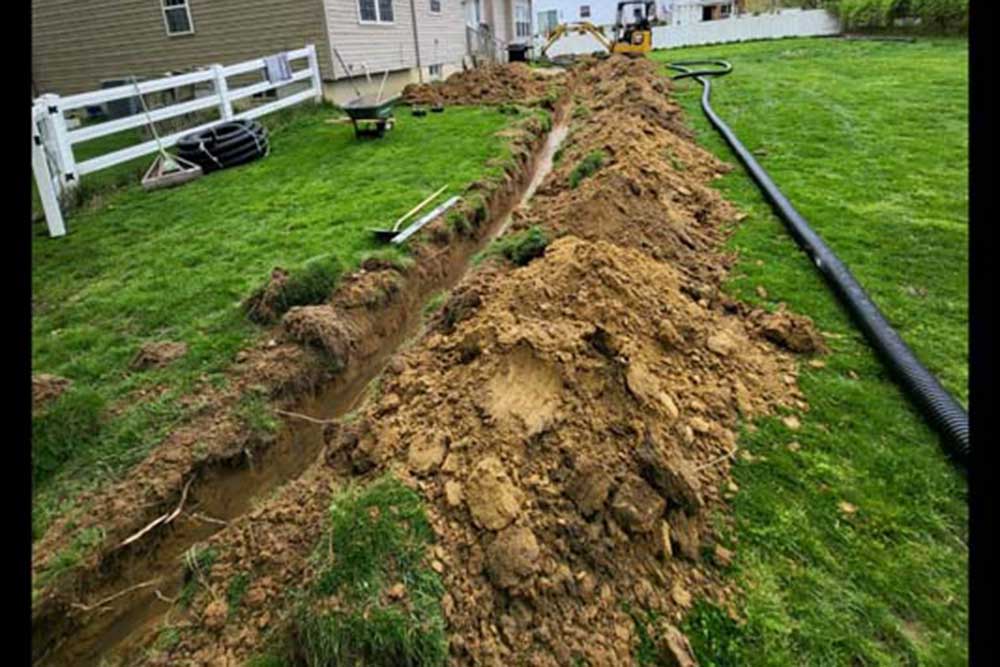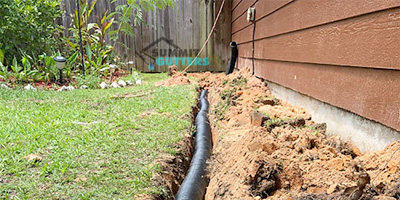
Say Goodbye to Waterlogging: Best Drainage Systems for Your Garden in Coventry
Waterlogging is one of the most frustrating challenges gardeners face, especially in areas like Coventry where frequent rainfall can leave your yard soaked and plants drowning in excess water. This condition not only suffocates plant roots but can also lead to disease, soil erosion, and long-term garden damage. The good news is that there are several effective drainage systems designed to prevent waterlogging and keep your garden healthy.
Here’s a guide to the best garden drainage solutions systems for your garden in Coventry, ensuring you can say goodbye to waterlogging and protect your outdoor space for years to come.
1. French Drains: Efficient and Effective Water Redirection
One of the most popular and reliable drainage solutions is the French drain. This system consists of a trench filled with gravel or rock, and a perforated pipe placed at the bottom. The pipe allows water to filter through and flow away from the problem area, often towards a designated soakaway or storm drain. French drains work particularly well for areas with poor soil drainage or low-lying spots prone to pooling.
Benefits:
- Redirects excess water to a safe location, preventing accumulation in garden beds.
- Great for areas where water naturally collects, such as depressions or at the base of slopes.
- Can be installed discreetly, blending into the garden’s landscape.
Best for: Gardens with heavy clay or poorly draining soil where water tends to collect.
2. Soakaways: An Underground Solution for Excess Water
A soakaway is an underground drainage system designed to absorb excess water and prevent flooding. It collects water from surface drains or French drains and allows it to gradually seep into the surrounding soil. This is ideal for areas with limited space for above-ground drainage solutions and for properties with poor natural drainage.
Benefits:
- Perfect for gardens with compacted or clay-heavy soil, where surface water struggles to drain.
- Eco-friendly solution that helps recharge groundwater while avoiding runoff.
- Can be integrated with French drains or surface drains for effective water management.
Best for: Gardens with limited space for surface drainage or where water needs to be absorbed without causing erosion.
3. Swales: Shallow Trenches for Natural Water Flow
A swale is a shallow, grassy trench designed to capture and redirect water away from problem areas in the garden. Swales use natural vegetation to help absorb water and reduce surface runoff. This makes them an excellent option for larger gardens or areas where water tends to run off slopes, causing erosion or pooling.
Benefits:
- Low-maintenance and natural drainage solution that integrates well with garden landscaping.
- Helps to reduce soil erosion by slowing down water flow and allowing for better water absorption.
- Ideal for large gardens or sloped areas that experience excess water runoff.
Best for: Gardens with sloped terrain or areas prone to surface runoff and erosion.
4. Permeable Paving: A Sustainable Way to Manage Rainwater
Permeable paving allows rainwater to pass through the surface and infiltrate into the ground beneath, rather than running off into your garden. This drainage solution is ideal for areas like patios, walkways, and driveways that often contribute to waterlogging by redirecting rainwater into your garden beds.
Benefits:
- Reduces surface runoff by allowing water to filter through paved surfaces.
- Helps maintain the aesthetic of your garden while managing water effectively.
- Sustainable option that contributes to overall garden health by reducing erosion and waterlogging.
Best for: Hard-surfaced areas like driveways, patios, and garden paths, where water runoff is common.
5. Surface Water Drains: Channeling Water Away from Garden Beds
Surface water drains are designed to capture rainwater running off paved areas, lawns, or garden beds. These drains use grated channels or slot drains placed along the edges of the problem area to direct water into an underground system or soakaway. Surface water drains are a quick and efficient solution for diverting excess rainwater and preventing pooling.
Benefits:
- Effectively prevents water from pooling around garden beds and walkways.
- Can be installed in key areas where water tends to gather, such as along edges of patios, driveways, or flower beds.
- Simple installation that minimizes disruption to your garden.
Best for: Areas around patios, walkways, or driveways where water runoff is a problem.
6. Gutter and Downspout Extensions: Redirect Roof Water Away from Garden Beds
Heavy rainfall can cause gutters to overflow, and without proper downspouts, water can flow directly into your garden, causing waterlogging around your foundation or garden beds. Installing gutter and downspout extensions helps channel this water further away from your plants and garden, directing it toward a drainage system like a soakaway or storm drain.
Benefits:
- Prevents rainwater from flooding garden beds and lawn areas near the house.
- Protects your home’s foundation from water damage.
- Affordable and easy-to-install solution for homes with roof runoff issues.
Best for: Homes where rainwater runoff from the roof contributes to waterlogging near garden beds or the foundation.

7. Raised Garden Beds: Creating Elevated Growing Spaces
If your garden is prone to waterlogging due to heavy clay or compacted soil, creating raised garden beds can provide a simple yet effective drainage solution. By elevating the growing area above the surrounding soil, you can improve water flow and reduce the risk of root rot. Raised beds also allow for better soil management and make it easier to amend soil quality with organic matter.
Benefits:
- Prevents water from accumulating around plant roots, ensuring better oxygenation.
- Allows for improved control over soil quality, texture, and moisture levels.
- Helps prevent erosion and keeps plants dry during periods of heavy rainfall.
Best for: Gardens with poorly draining soil or areas where water regularly collects and saturates the soil.
8. Sump Pumps: A Backup System for Flood-Prone Gardens
In extreme cases of waterlogging, a sump pump can be used to remove excess water from low-lying areas of your garden. Sump pumps collect water from a sump pit and pump it out of the area, typically into a designated drainage system or away from the garden. This system is especially useful in flood-prone areas where water accumulation is frequent.
Benefits:
- Quickly removes water from flooded areas to prevent damage to plants and garden structures.
- Can handle large volumes of water during storms or heavy rainfall.
- Provides peace of mind for homes in areas prone to flooding or high water tables.
Best for: Gardens in flood-prone areas or where excessive water accumulation is common after heavy rain.
Conclusion
Waterlogging doesn’t have to ruin your garden. With the right drainage solutions, you can prevent water from pooling in your yard and protect your plants from root rot and other moisture-related issues. From French drains and soakaways to raised garden beds and permeable paving, these drainage systems will help keep your garden in Coventry dry, healthy, and thriving.
By understanding your garden’s unique drainage needs and implementing the most effective solution, you can say goodbye to waterlogging and enjoy a flourishing garden all year long.